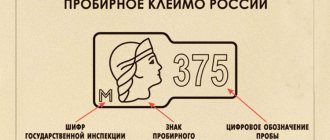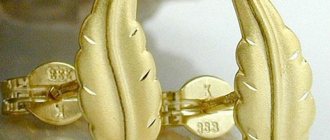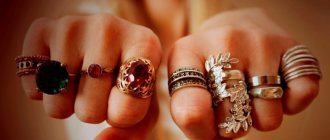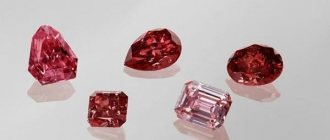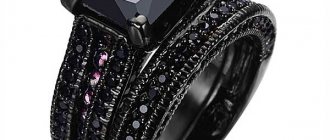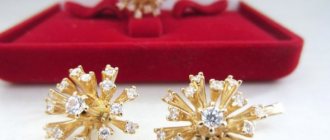Features of Turkish gold
All gold is imported; this precious metal is not mined in Turkey.
Turkish gold is gold + silver, which is why it is so yellow.
The price of the jewelry includes more handmade work, and when you sell you only pay for the cost of gold or diamond and then you will lose a lot of money.
Turkish gold is characterized by the presence of low-grade impurities, and therefore has a lower cost. Some elements of the alloy composition can even cause allergies in humans. No one can guarantee their strength and durability.
Turkish gold: fineness, prices per gram and main differences
The gilded product takes on a milky hue. If the gold is real, then no reaction will take place.
Sound test
If you take a gold item and throw it onto the surface of the table, then the real metal will ring loudly, like crystal. For such an experience, rings, earrings, but not long jewelry (chains, bracelets) are suitable.
Vinegar test
Pour some vinegar into the container and place the decoration there. Nothing bad will happen to real gold, but fake gold will darken in two minutes.
Iodine test
Iodine is a very good test for the authenticity of jewelry. To do this, you only need to apply one drop to the inside of the product. Gold will remain unchanged. The fake decoration will darken. It can turn either light gray or black.
ANY CHEMICAL TEST IS POSSIBLE ONLY ON THE SURFACE OF THE DECORATION. THE INSIDE IS CHECKED WHEN A PERSON IS READY TO DESTROY THE PRODUCT.
You can also ask experts how to distinguish gold from a fake, who will help you quickly and using several ways to determine whether the jewelry is real. Gilding is almost real metal.
Turkish gold samples
In Russia, the quality of gold is checked in accordance with legislative acts. The most common standard is 585. Jewelry made from this alloy is reasonably priced, has an attractive appearance and is highly durable. The alloy masterpiece includes zinc, silver, copper and palladium. The main characteristics of the yellow metal depend on the ratio of these elements.
Important! Turkish gold often does not have a hallmark indicating its fineness, unlike Russian gold, which must be hallmarked in accordance with the law.
Turkish jewelry is made mainly from American and German gold. The exact composition of the alloy in a particular product is impossible, and therefore its strength cannot be guaranteed. Differences between Russian and Turkish gold:
- Any Russian jewelry has a tag indicating the purity.
- When purchasing jewelry in Turkey, there is usually no guarantee that the sample matches the alloy alloy.
- Turkish legislation does not have regulations for the production of gold alloy, so tourists often become owners of jewelry made from low-quality material with a large number of impurities.
The fineness can vary from 0 to 1000. This figure indicates the percentage of pure metal that is present in the alloy. However, such markings are placed on Russian-made products. Turkish gold is marked as follows - “14K”, which means 14 carats. This indicator corresponds to 585 samples.
Gold color
For those who are not accustomed to European jewelry, Turkish jewelry looks unusual. Some even begin to doubt whether they are really made of gold? The fact is that European jewelry is most often made of yellow gold. There are only three shades in total:
- Red gold (traditional for Russia) received its hue due to the admixture of copper.
- Yellow - the proportion of copper here is very small, the composition includes silver.
- White - gets its noble shade, different from silver products, due to the admixture of palladium.
For 20 years, the Turks have already taken into account the commitment of Russian tourists to red gold, so it is included in the assortment. Turkish jewelry made from 2-3 types of gold is very beautiful.
Gold tone
You can tell if the seller is deceiving you by the type of jewelry. For example, low-grade gold has a reddish tint. It is present due to the presence of large amounts of copper in the alloy.
Possible gold colors:
- yellow - this alloy contains 17-18% silver and 8-22% copper;
- white - the alloy has 16-20% nickel and 5-25% silver;
- pink - this type of gold has the highest percentage of copper - from 12 to 32%;
- Pale yellow-green – gold alloy composed of 38% silver, 58.5% gold and 3.25% copper.
When choosing Turkish gold, you should focus not only on color, but also on sound. Let's say if you throw a cheap alloy ring and a high-quality yellow metal ring into the air, they will make different sounds when they fall on your palm.
When inspecting jewelry, you should first of all pay attention to its color. The risk of being deceived in a serious store or in a shop at the Grand Bazaar is minimal. However, it is still worth taking a closer look at the shade of the metal. For example, Russian gold contains copper, which gives the metal a reddish tint. Turkish jewelers add palladium, tin, aluminum, and silver to the alloy. However, the main purpose of such actions is not to deceive the buyer, but to give gold a special shade.
Popular alloys
The unusual color of a precious metal does not always indicate its low quality. For example, a gold product in Turkey may correspond to the 585 standard, but differ noticeably from the Russian precious metal in color.
Important! When contacting a buyer, it is worth considering that he may not accept gold containing aluminum or palladium. For example, amethyst gold, which has a soft purple hue, is very popular in Turkey. Jewelry made from it looks quite impressive, but the metal itself is quite fragile and brittle. It will not be possible to hand it over to a workshop, since few craftsmen will agree to work with such an alloy.
White gold in Turkey is usually made with the addition of nickel, which makes the alloy significantly cheaper. Its main disadvantage is rapid oxidation, susceptibility to corrosion and the likelihood of allergies.
Common gold alloys used in Turkey:
- Electron - with the addition of silver.
- Goldin - the alloy contains copper.
- Belgica - gold is mixed with nickel and chromium.
Entrepreneurial Turks can sell products made from the above alloys as jewelry.
Turkish gold coins
Gold coins in Turkey are made of 22-karat gold and are considered an integral part of Turkish culture as coins are given as gifts at social events such as weddings and circumcision ceremonies.
Gold coins in Turkey are divided into two types: decorative coins, called ziynet altin, and Republic coins, which are called Cumhuriyet Altını .
Ornamental coins
The decorative coins feature an image of Ataturk on one side and the phrase “Turkish Republic” and the date of issue on the other.
The coin is decorated with stars and designs and has a handle on the top for hanging or gifting as a medal.
Quarter gold Turkish lira
The Turkish Golden Quarter is considered to be the most popular gold coin in Turkey as it is heavily used by Turks as a gift at social events.
"small gold-küçük altın in Turkey , as it is the smallest denomination of gold coins.
The gold quarter lyre weighs between 1.754 grams and 1.6065 grams and is made from 22 carats and has a diameter of 18 mm.
Quarter Turkish Golden Lira
Half Turkish Golden Lira
Half of a golden lyre weighs 3.5 grams and contains the equivalent of 3.21 grams of pure gold, while the remaining 0.29 grams is made of copper or silver.
Gold pollires are made of 22-karat gold, the diameter of the coin is 22 mm.
The image from right to left shows some of the gold coins in Turkey: "full lira, half lira, quarter lira".
Golden lyre
A 22 carat gold lire weighs about 7 grams and contains 6.42 grams of pure gold.
2.5 gold liras
2.5 gold lire is equal to 10 quarters of gold or 5 halves, and it is called Gremse, and its weight reaches 14 grams.
Its price is higher than other gold coins due to lack of production and difficulty of purchasing, many do not choose to invest in 2.5 gold lira as it is the least traded type of Turkish gold coin in the market.
Five gold lire
The five gold lira is considered a haven for investors as it is the highest coin among decorative gold coins, weighing up to 35 grams in 22k gold.
5 Turkish gold lira is one of the most valuable gifts, which in some places is called " beshi " and is given at weddings and circumcision ceremonies.
Republic gold
Republic gold is a type of gold that is slightly different from a decorative gold coin, it comes in a total of 10 different diameters and weights in five varieties such as five, two and a half, one, half and quarter.
The phrase "Republic of Turkey" and the founding date of the republic in 1923 are engraved on the railway coins on one side, while on the other end the phrase "Hakimiyet Milletindir" is written, meaning "sovereignty of the nation" and the word "Ankara" is written at the bottom.
The Treasury Mint issues railroad currency, and the following table provides a comparison of the weights of Republic gold and decorative gold.
| Type | Republic gold (weight in grams) | Decorative gold (weight in grams) |
| quarter | 1 804 | 1,754 |
| Half | 3 608 | 3 508 |
| One | 7 216 | 7 016 |
| Two and a half | 18 040 | 17 540 |
| 5 | 36 080 | 35 080 |
Image showing the difference between Republic gold, "mint gold" and decorative gold."
Ottoman gold lyre "Rashad Gold"
The Ottoman gold lira, called "Rashad Altın", is a type of gold coin that was minted during the reign of Sultan Muhammad Rashad in 1909.
The weight of the Ottoman golden lira is 7.2 grams of 22 carat gold and its price is higher than the Turkish golden lira due to the difference in weight, as well as historical value and supply shortages.
The Ottoman gold lyre Rashad shares with the gold of the republic only 22-karat gold and differs in all other characteristics of the weight and diameter of the coin, as well as the inscription on it.
Ottoman gold lyre "Rashad Gold"
How much is Turkish gold worth?
Tourists buying jewelry in Turkish shops are led by very low metal prices, often comparable to the cost of silver in Russia. The cheapest jewelry is offered by street vendors. The price for one gram of gold can be 40-65 dollars.
When choosing gold, it is important to consider the place of sale. Even though the quality of the products is identical, their prices may differ in different localities. For example, a gold chain in Kemer, popular among tourists, can cost $400-500. In a small locality, its cost may be 100-200 dollars lower.
What determines the price of Turkish gold:
- from the price of gold on the world stock exchange;
- competition - in Turkey there are a lot of shops selling gold, which causes prices to go down;
- the country's position in the ranking of countries for sales of gold jewelry - Turkey ranks second;
- location of the retail outlet - in large cities like Istanbul, gold is sold at a higher price, but the quality may be even worse than in a small shop in a remote village. In resort areas, gold prices are aimed at tourists, so they are often inflated.
The lowest price per gram of Turkish gold is considered to be $30-35.
Customer Reviews
“I have several bracelets and chains from Turkish masters of stunning beauty. I haven’t taken it to a jeweler, but it looks like real gold and I haven’t had any complaints in three years.”
“While on vacation in Istanbul, we bought a bracelet, tempted by the low price. The bracelet ended up getting stained after 2 weeks. After another month, the top layer was worn off, and it turned out that it was silver with gilding.”
“We bought engagement rings from Zen Diamond in Istanbul based on reviews from good friends. They've been around for over a year now and no complaints. True, we clean it regularly, but we do the same with our domestic products.”
Where is it profitable to buy gold?
Despite the fact that in large cities the prices for Turkish gold are higher, in certain places you can buy it at a wallet-friendly price:
- Istanbul - Grand Bazaar (Kapali Çarshi). You should enter from the Beyazide gate, but you should not buy at the entrance. The closer to the center of the bazaar, the lower the prices for Turkish gold.
- Kemer - you should buy gold not in the city itself, but in the village of Chamyuva, located 10 minutes away from it.
- Shops at large jewelry factories. In such retail outlets it is appropriate to bargain up to 100-200% of the original price, i.e. reduce the price by 2-3 times. It is not profitable for sellers, as well as guides who receive a certain percentage of sales, for people to leave without purchasing. For this reason, bidding is arranged by both buyers and sellers.
The peculiarity of Turkish gold jewelry is its originality and variety of forms.
It is better to buy Turkish gold either in company stores or at the Kapala Charshi bazaar. You should not pay more than $60 for 1 gram of 580 sample.
In Turkey, you can buy original jewelry with sophisticated oriental designs, but not all of them will be considered jewelry. Turkish gold is a unique find for tourists. Jewelry made from it has a unique design, attracts with its brilliance and the best price. However, it is worth remembering that jewelry made of high-quality metal cannot be cheap.
Where to buy and average price per 1 gram
Market stalls in Istanbul and resort towns in Turkey are not the best place to buy jewelry if you want to buy a really high-quality item. The risk of becoming the owner of a fake is much higher there. In search of genuine gold jewelry, it is better to go to large jewelry stores.
Zen Diamond and Storks stores are considered one of the most popular stores in Istanbul. Both showrooms have offerings in both gold and silver. The price of yellow precious metal for 1 gram starts from $50. Below you will find the price in Turkish Lira per gram:
Benefits of Turkish gold jewelry
Jewelry made in Turkey comes in various styles:
- Turkish traditional - such jewelry can be found in specialized stores, where locals often buy gold for gifts for celebrations. These pieces have a high gold content and are usually 24 karats.
- Byzantine. The style involves a combination of red, white and yellow metal with precious stones.
- European. Turkish decorative items made in this style combine the finest weaves and massive elements.
A special feature of Turkish jewelry is the drip gold technique, which is used to create unique lace. The price for such jewelry varies from $40 to $60 per gram.
Try
The yellow tint does not affect the sample in any way - it is the same here, 585. It is only designated differently - the number 585 corresponds to 14K (karat). Products with precious stones are often higher, 750 grade or 18K. And finally, pure gold (coins and bracelets) have 999 purity - 24K.
There must be a hallmark on the back of the product, but it can be indicated by carat value - there is no deception here.
In large shopping centers, a certificate is issued for each product, which indicates the carat of gold (fineness) and the carat (size) of precious stones. A separate certificate must also be issued for designer products from Cartier, Tiffani, Roberto Bravo.
Bargaining
The cost of Turkish gold, indicated in the price list of many stores, is deliberately inflated in case of inevitable bargaining with buyers. Knowing this, tourists buy jewelry at 2 and sometimes 3 times cheaper than the original cost.
You can bargain even in large stores. Managers receive a percentage of sales, and in some cases even a fine if a certain number of visitors leave without purchasing. You can use this to get discounts on certain products.
Is it worth buying gold in Turkey?
The low price and popularity of Turkish gold have given rise to many rumors about its poor quality. However, this only applies to small shops that open exclusively at the beginning of the season and offer tourists jewelry made from low-quality alloys.
Large stores located in tourist areas present certificates of quality for their goods. In addition, their owners always check the purchased products. They strive to get regular customers.
What are buyers saying?
Reviews about Turkish gold can be found in a variety of ways: both good and negative. Those who admire the imported jewelry cite an attractive price and aesthetic appearance as arguments. The products of Turkish jewelers truly amaze with their beauty and special oriental charm, which is also inherent in Indian jewelry. Original rings and earrings delight tourists who come to relax on the Mediterranean coast, and their low cost allows you to buy a gift not only for yourself, but also for relatives.
Tax free shopping in Turkey
According to the Tax Free program, a foreign citizen staying in Turkey for less than 6 months can return a tax on purchased goods in the amount of 18%. One of the mandatory conditions is that purchased items must be taken out in personal luggage. Jewelry is included in the Tax Free program, so part of its cost can be returned.
Jewelry products deserve attention and respect. In local shops and stores you can find original designer jewelry for every budget.

